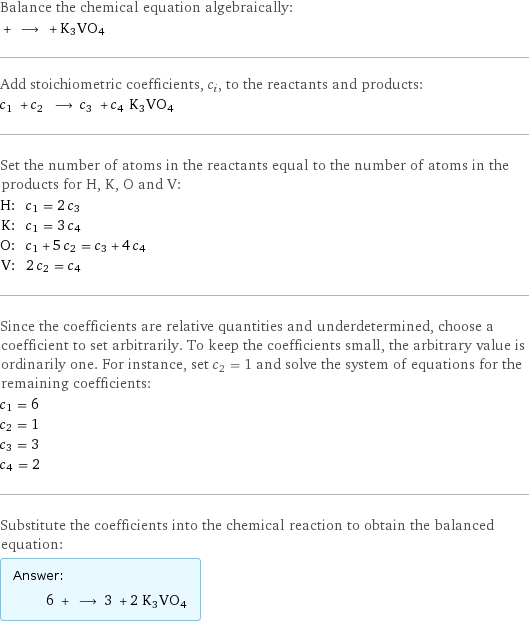Input interpretation

potassium hydroxide + vanadium pentoxide ⟶ water + K3VO4
Balanced equation

Balance the chemical equation algebraically: + ⟶ + K3VO4 Add stoichiometric coefficients, c_i, to the reactants and products: c_1 + c_2 ⟶ c_3 + c_4 K3VO4 Set the number of atoms in the reactants equal to the number of atoms in the products for H, K, O and V: H: | c_1 = 2 c_3 K: | c_1 = 3 c_4 O: | c_1 + 5 c_2 = c_3 + 4 c_4 V: | 2 c_2 = c_4 Since the coefficients are relative quantities and underdetermined, choose a coefficient to set arbitrarily. To keep the coefficients small, the arbitrary value is ordinarily one. For instance, set c_2 = 1 and solve the system of equations for the remaining coefficients: c_1 = 6 c_2 = 1 c_3 = 3 c_4 = 2 Substitute the coefficients into the chemical reaction to obtain the balanced equation: Answer: | | 6 + ⟶ 3 + 2 K3VO4
Structures

+ ⟶ + K3VO4
Names

potassium hydroxide + vanadium pentoxide ⟶ water + K3VO4
Chemical names and formulas

| potassium hydroxide | vanadium pentoxide | water | K3VO4 formula | | | | K3VO4 Hill formula | HKO | O_5V_2 | H_2O | K3O4V name | potassium hydroxide | vanadium pentoxide | water |
Substance properties

| potassium hydroxide | vanadium pentoxide | water | K3VO4 molar mass | 56.105 g/mol | 181.88 g/mol | 18.015 g/mol | 232.23 g/mol phase | solid (at STP) | solid (at STP) | liquid (at STP) | melting point | 406 °C | 690 °C | 0 °C | boiling point | 1327 °C | 1750 °C | 99.9839 °C | density | 2.044 g/cm^3 | 3.35 g/cm^3 | 1 g/cm^3 | solubility in water | soluble | | | surface tension | | | 0.0728 N/m | dynamic viscosity | 0.001 Pa s (at 550 °C) | | 8.9×10^-4 Pa s (at 25 °C) | odor | | | odorless |
Units
